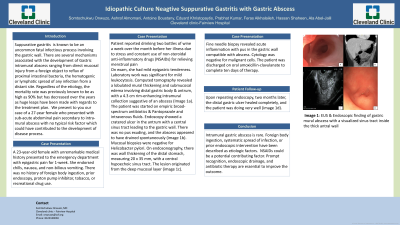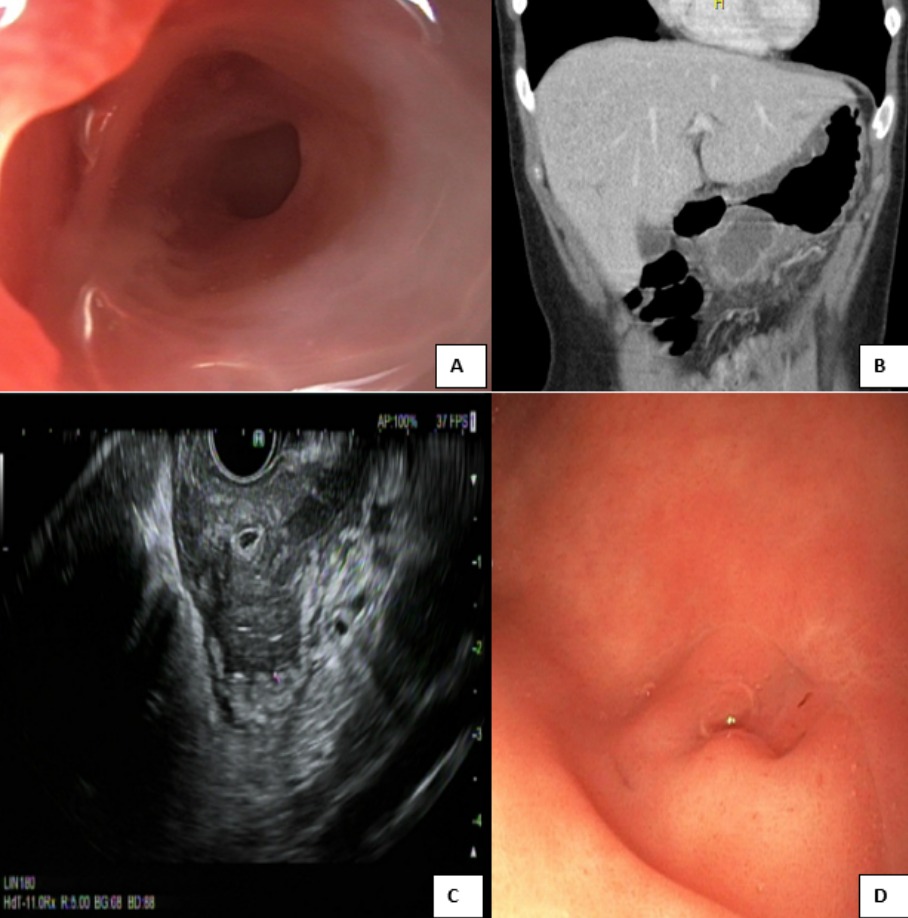Back


Poster Session E - Tuesday Afternoon
Category: Stomach
E0723 - Idiopathic Culture-Negative Suppurative Gastritis With Gastric Abscess
Tuesday, October 25, 2022
3:00 PM – 5:00 PM ET
Location: Crown Ballroom

Has Audio

Somtochukwu Onwuzo, MD
Cleveland Clinic Foundation
Cleveland, OH
Presenting Author(s)
Somtochukwu Onwuzo, MD, Ashraf Almomani, MD, Antoine Boustany, MD, MPH, Eduard Krishtopaytis, MD, Prabhat Kumar, MD, Feras Alkhalaileh,, MD, Ala Abdel Jalil, MD, Hassan M. Shaheen, MD
Cleveland Clinic Foundation, Cleveland, OH
Introduction: Suppurative gastritis is an uncommon infectious process involving the gastric wall from direct mucosal injury caused by a foreign object, reflux of proximal intestinal bacteria, and hematogenic or lymphatic spread from a distant infection. Intramural gastric abscess is rare with high mortality and morbidity if left untreated. Immediate management is required once there is clinical suspicion.
Case Description/Methods:
A 23-year-old female with unremarkable medical history presented to the emergency department with epigastric pain for 1-week. She endorsed chills, nausea, and non-bilious vomiting. There was no history of foreign body ingestion, prior endoscopy, proton pump inhibitor, tobacco, or recreational drug use. Patient reported drinking two bottles of wine a week over the month before her illness due to stress and constant use of non-steroidal anti-inflammatory drugs (NSAIDs) for relieving menstrual pain. On exam, she had mild epigastric tenderness. Laboratory work was significant for mild leukocytosis. Computed tomography revealed a lobulated mural thickening and submucosal edema involving distal gastric body & antrum, with a 4.3 cm rim-enhancing intramural collection suggestive of an abscess (image 1a). The patient was started on empiric broad-spectrum antibiotics & Pantoprazole and intravenous fluids. Endoscopy showed a cratered ulcer in the antrum with a central sinus tract leading to the gastric wall. There was no pus exuding, and the abscess appeared to have drained spontaneously (image 1b). Mucosal biopsies were negative for Helicobacter pylori. On endosonography, there was wall thickening of the distal stomach, measuring 20 x 35 mm, with a central hypoechoic sinus tract. The lesion originated from the deep mucosal layer (image 1c). Fine needle biopsy revealed acute inflammation with pus in the gastric wall compatible with abscess. Cytology was negative for malignant cells. The patient was discharged on oral amoxicillin-clavulanate to complete ten days of therapy. Upon repeating endoscopy, two months later, the distal gastric ulcer healed completely, and the patient was doing very well (image 1d).
Discussion: Intramural gastric abscess is rare. Foreign body ingestion, systematic spread of infection, or prior endoscopic intervention have been described as etiologic factors. NSAIDs could be a potential contributing factor. Prompt recognition, endoscopic drainage, and antibiotic therapy are essential to improve the outcome.

Disclosures:
Somtochukwu Onwuzo, MD, Ashraf Almomani, MD, Antoine Boustany, MD, MPH, Eduard Krishtopaytis, MD, Prabhat Kumar, MD, Feras Alkhalaileh,, MD, Ala Abdel Jalil, MD, Hassan M. Shaheen, MD. E0723 - Idiopathic Culture-Negative Suppurative Gastritis With Gastric Abscess, ACG 2022 Annual Scientific Meeting Abstracts. Charlotte, NC: American College of Gastroenterology.
Cleveland Clinic Foundation, Cleveland, OH
Introduction: Suppurative gastritis is an uncommon infectious process involving the gastric wall from direct mucosal injury caused by a foreign object, reflux of proximal intestinal bacteria, and hematogenic or lymphatic spread from a distant infection. Intramural gastric abscess is rare with high mortality and morbidity if left untreated. Immediate management is required once there is clinical suspicion.
Case Description/Methods:
A 23-year-old female with unremarkable medical history presented to the emergency department with epigastric pain for 1-week. She endorsed chills, nausea, and non-bilious vomiting. There was no history of foreign body ingestion, prior endoscopy, proton pump inhibitor, tobacco, or recreational drug use. Patient reported drinking two bottles of wine a week over the month before her illness due to stress and constant use of non-steroidal anti-inflammatory drugs (NSAIDs) for relieving menstrual pain. On exam, she had mild epigastric tenderness. Laboratory work was significant for mild leukocytosis. Computed tomography revealed a lobulated mural thickening and submucosal edema involving distal gastric body & antrum, with a 4.3 cm rim-enhancing intramural collection suggestive of an abscess (image 1a). The patient was started on empiric broad-spectrum antibiotics & Pantoprazole and intravenous fluids. Endoscopy showed a cratered ulcer in the antrum with a central sinus tract leading to the gastric wall. There was no pus exuding, and the abscess appeared to have drained spontaneously (image 1b). Mucosal biopsies were negative for Helicobacter pylori. On endosonography, there was wall thickening of the distal stomach, measuring 20 x 35 mm, with a central hypoechoic sinus tract. The lesion originated from the deep mucosal layer (image 1c). Fine needle biopsy revealed acute inflammation with pus in the gastric wall compatible with abscess. Cytology was negative for malignant cells. The patient was discharged on oral amoxicillin-clavulanate to complete ten days of therapy. Upon repeating endoscopy, two months later, the distal gastric ulcer healed completely, and the patient was doing very well (image 1d).
Discussion: Intramural gastric abscess is rare. Foreign body ingestion, systematic spread of infection, or prior endoscopic intervention have been described as etiologic factors. NSAIDs could be a potential contributing factor. Prompt recognition, endoscopic drainage, and antibiotic therapy are essential to improve the outcome.

Figure: Image 1: EUS Finding of gastric mural abscess with a visualized sinus tract inside the thick antral wall
Disclosures:
Somtochukwu Onwuzo indicated no relevant financial relationships.
Ashraf Almomani indicated no relevant financial relationships.
Antoine Boustany indicated no relevant financial relationships.
Eduard Krishtopaytis indicated no relevant financial relationships.
Prabhat Kumar indicated no relevant financial relationships.
Feras Alkhalaileh, indicated no relevant financial relationships.
Ala Abdel Jalil indicated no relevant financial relationships.
Hassan Shaheen indicated no relevant financial relationships.
Somtochukwu Onwuzo, MD, Ashraf Almomani, MD, Antoine Boustany, MD, MPH, Eduard Krishtopaytis, MD, Prabhat Kumar, MD, Feras Alkhalaileh,, MD, Ala Abdel Jalil, MD, Hassan M. Shaheen, MD. E0723 - Idiopathic Culture-Negative Suppurative Gastritis With Gastric Abscess, ACG 2022 Annual Scientific Meeting Abstracts. Charlotte, NC: American College of Gastroenterology.
